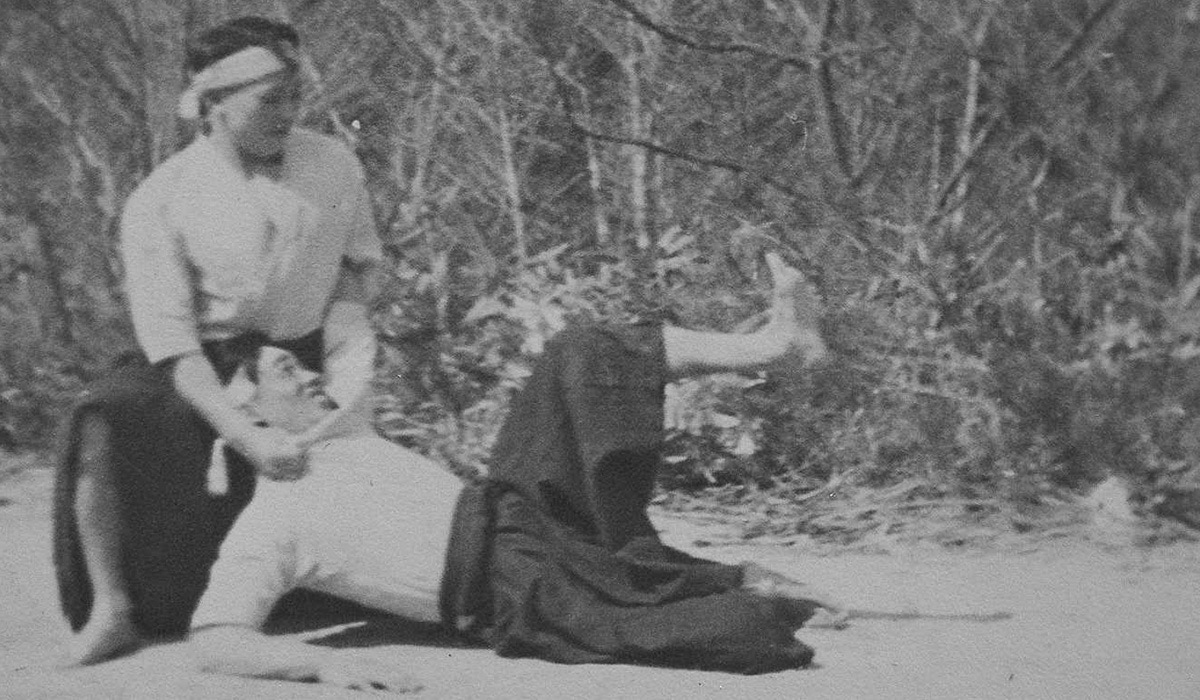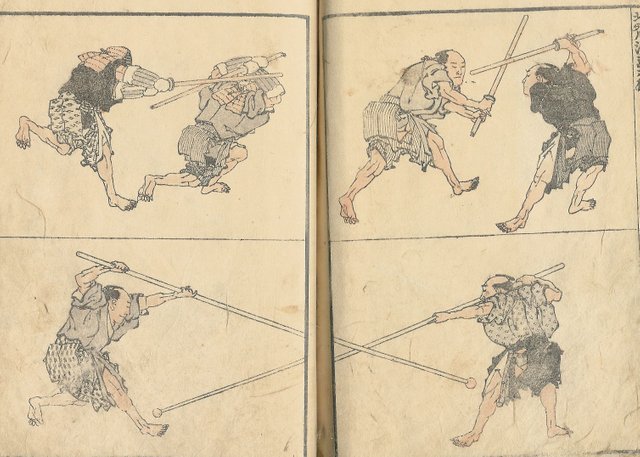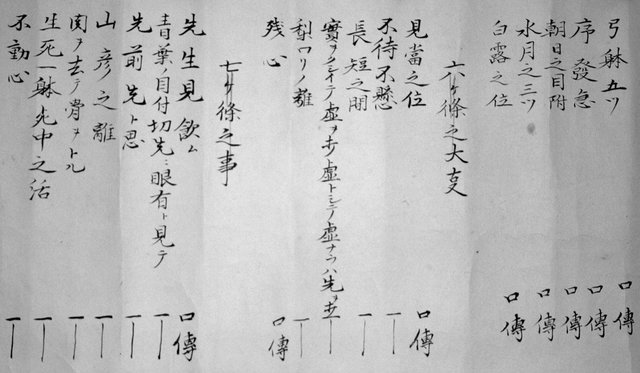
Martial artists from the Yoshin Ryu school of Jujutsu performing Enbu (demonstration)
Originally published on my blog, Jinenkan Dojo, The Roots of Classical Jujustu
The classical study of Japanese Jujutsu has taken the back seat to the modern and commercialized styles of Jujutsu. While there are many great books (and even .many more not so great), written on the history of Jujutsu, it is very often associated with ground grappling, ring fighting and submission techniques.
While these associations certainly have their place during the end of the 19th century up to today, the roots of Jujutsu are surprisingly quite different and it is with a spirit of preservation that we study the old traditions of this dynamic art.
The nation of Japan has a fascinating and rich history. It is one that shares a similar current with the rest of human history, being a nation of strong people carved out of civil wars. In order to understand why the Japanese martial arts have such a dominating presence in the west, one must take a brief look at the history of the nation.
For over four hundred years Japan existed as an island of competing provinces. These provinces fought constantly for many reasons, each employing their individual systems of combat. At the beginning of the seventeenth century, this warring period came to a halt and many of the professional soldiers found the need to seek out another career.

Hokusai sketchbook of martial arts training
Martial systems up to this point had been handed down from one headmaster to the next. Their responsibility to the lineage was strict preservation of history, meticulously teaching and when mastered, additions and improvements due to the changing course of the times. As times and technology changed, so too did the rules of combative engagement.
During this period of peace, these headmasters went about and began to openly teach the crafts which had been previously studied by the military elite. The headmaster would otherwise be out of work, as war had stopped and the demand for their skills had diminished.
This was the beginning of a critical era for the Japanese martial arts. It was during this period that the philosophies of the warrior rule became the ‘way’ it was the era of sword saints.
Hundreds of combative systems were codified during this period, becoming legitimate schools. The most celebrated and popular of these combative systems was the Jujutsu. The gentle-art as it is so regularly regarded as, was not so gentle.
Through history Jujutsu had been recorded in scrolls of various schools as many different terms including Yawara, Kenpo, Taijutsu and Jutaijutsu to name just few. Jujutsu during this period was taught as a means of un-armed and armed defense, with specific hand held weapons specific to a particular school.
Jujutsu included methods of bone breaking strikes, soft tissue attacks, joint lock and breaking forms, armor grappling, un-armed weapon defensives, specific weapon forms and resuscitation techniques.
During this period of relative peace, the samurai classes were forced to seek other means of employment, as the warring days were over. Some became law enforcement officials or personal guards while others operated as mercenaries. The police were usually made up of lower samurai classes with assistants who were not of this class and forbidden to carry the sword.
![image004[1].jpg](https://steemitimages.com/DQmdjwvopG66MnyrLP5pCfm5yd5wGoBbG4A1ZRfLPLhtto7/image004%5B1%5D.jpg)
Japanese Jujutsu masters, 1921
Because of a society defined by the inequality of individuals, it was of absolute importance that the police were proficient in arresting techniques that would not hurt or kill an offender holding higher social status than he. When dealing with offenders who were of the samurai class, a police officer during this era had to be extremely capable of disarming and restraining the most elite of soldiers.
As the decades past, this community of police officers became a hereditary trade, past on from father to son.
Though not within the echelons of the nobility, they still came from samurai stock and were shunned because of the lower class tasks these officers took upon themselves. An extremely proud group of professionals, the Japanese police of this era created their own systems of fighting which had to constantly be updated due to the changing patterns of fighting style and weaponry.
Even after the development of the Japanese national police force on 1847, their traditions continued. The west had landed on the shores of Japan and so too had completely foreign methods of close quarter fighting. Adaptation was demanded for the Japanese police officer during the Edo period.
From the late nineteenth century up to the beginning of world war two, the common practice for the Japanese police officer and soldier was found in the sport arts of sword fencing (Kendo) and Judo. At the time, Judo had seen immense popularity as well as delivering a Japanese sport to the Olympic games and every academic institutions curricula for physical fitness.
While Kendo and Judo are both merit able arts themselves, they served more for physical conditioning of the Japanese police officer rather than offering a tactical formula for arresting criminals.
As Japan became more modern influenced by the west, their civil conditions saw change alongside their laws and how they were enforced. Now, the Japanese police officer needed to subdue a criminal and limit the amount of injury caused in a whole new way.
As a result of Judo’s popularity and the passing of times, the old schools were somewhat forgotten by the civil authorities. It must be remembered that many of the old martial art traditions were particular to field combat, movement in mass, tactics involving large groups of soldiers and the strategies to employ the necessary techniques to see through to victory. The police officer was an individual and for this reason, much of the old combative methods were not applicable to their needs.
While these old traditions were no longer recognized by civil authorities, it should be pointed out that many police and military personnel at this time still trained under the auspices of specialized headmasters of old-combat schools. After the war in the Pacific came to a close, the practice of martial arts became illegal.
In 1947, a committee consisting of administrators from the Tokyo Metropolitan Police came together to update the tactics being used by front line officers. With a panel of high-ranking officials from various traditional Jujutsu lineages present, they restructured the means in which a modern front line police officer would employ unarmed self-defense tactics to diffuse civil disturbances and violent crimes. Hundreds of statistically proven situations were reviewed and studied resulting in the re-application of many methods practiced in the older schools of Jujutsu along with the current applications of Kendo and Judo.
Their techniques and training syllabus were again modified to suit the times. Consistently the Japanese police have revisited their syllabus and continue to keep it extremely up to date, making their Taiho Jutsu method of training the most efficient and proven system of police restraint in the world.

Image of a densho (school documentation) of martial arts tradition
The history of Japanese police is truly amazing. It is amazing to see that the fraternity that was shared within the Yoriki and Doshin ranks was identical to that shared by modern day police here in the west. They were an extremely proud class that operated within each level of a strictly segregated society. Their methods of tactical defense was unquestionably recorded and trained to a razor sharp precision.
It would be a grave injustice to believe that the arts of Japanese restraint and submission were brought about in the twentieth century as a new development.
From the late nineteenth century up to the beginning of world war two, the common practice for the Japanese police officer and soldier was found in the sport arts of sword fencing (Kendo) and Judo. At the time, Judo had seen immense popularity as well as delivering a Japanese sport to the Olympic games and every academic institutions curricula for physical fitness. While Kendo and Judo are both merit able arts themselves, they served more for physical conditioning of the Japanese police officer rather than offering a tactical formula for arresting criminals.
As Japan became more modern influenced by the west, their civil conditions saw change alongside their laws and how they were enforced. Now, the Japanese police officer needed to subdue a criminal and limit the amount of injury caused in a whole new way.
As a result of Judo’s popularity and the passing of times, the old schools were somewhat forgotten by the civil authorities. It must be remembered that many of the old martial art traditions were particular to field combat, movement in mass, tactics involving large groups of soldiers and the strategies to employ the necessary techniques to see through to victory. The police officer was an individual and for this reason, much of the old combative methods were not applicable to their needs.
While these old traditions were no longer recognized by civil authorities, it should be pointed out that many police and military personnel at this time still trained under the auspices of specialized headmasters of old-combat schools.
After the war in the Pacific came to a close, the practice of martial arts became illegal.
Why the Japanese Systems?
This is a very good question.
Since time immemorial, the Japanese have been extremely particular about the documentation and recording of anything with even a slight degree of importance. It is in their heritage to maintain loyalty to the teaching of those who have tested and proven progressive methods of any action.
These methods will be perfected according to how they were recorded and taught, then and only then being modified to suit the times and changes. This is just as true for marital arts as it is for such acts as business, cooking, writing, etc.
For this reason, what a student of the true Japanese art learns is quite close to the original teachings and has only been improved upon through the ages. There have been no changes to suit the desire of someone else and because of Japan’s isolation through the ages there is little risk of cultural bias and sabotage.
In regard to the martial arts it must be remembered that Japanese culture is highly defined by it’s history of battle. Hundreds of years sheer combat have been recorded, documented. Their skills for fighting have left them impenetrable, bowing only to the atomic bomb. Truly we have much to learn.
More importantly, in regard to why the Japanese methods of arresting techniques are regarded with such a high caliber is because of how the Japanese people viewed the act of restraint. While the humanitarian conditions of feudal era Japan were quite different than today, the mere act of controlling a criminal was taken with absolute care to not humiliate the offender.
If a mistake were to happen which would cause shame to the offender, especially if the offender were of a higher social status than the police, then the police would be held accountable for such an act. For this reason, the Japanese police trained an entirely different craft of close quarter combat than that of the samurai or other martial artists of the time.
Hi! I am a robot. I just upvoted you! I found similar content that readers might be interested in:
https://www.jinenkandojo.com/blog/the-roots-of-classical-jujutsu
Downvoting a post can decrease pending rewards and make it less visible. Common reasons:
Submit
Hi @cheetah, (even though you're a bot) yup that's my article from my Dojo's website. I wrote it in 2010 and want to share it with the Steemit Community.
Downvoting a post can decrease pending rewards and make it less visible. Common reasons:
Submit
This is a really interesting and well-written post @adammitchell. I enjoyed reading it.
Downvoting a post can decrease pending rewards and make it less visible. Common reasons:
Submit